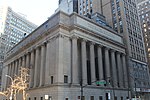Leaders of the World sign
1910 establishments in New York City1912 disestablishments in New York (state)Advertising structuresBroadway (Manhattan)History of New York City ... and 1 more
Midtown Manhattan

Leaders of the World (alternate title: The Fiery Chariot Race in New York) was an electric advertising sign in New York City from 1910 to 1912 and one of the largest in New York City when it was built. It displayed an animated scene of a Roman chariot race along with a text message for the advertiser. The sign began operation on July 19, 1910, and was destroyed in a storm on February 22, 1912. The sign's manufacturer ran an international contest to solicit marketing ideas. It was not a commercial success, but there were references to it in F. Scott Fitzgerald's writings.
Excerpt from the Wikipedia article Leaders of the World sign (License: CC BY-SA 3.0, Authors, Images).Leaders of the World sign
New York Manhattan
Geographical coordinates (GPS) Address Nearby Places Show on map
Geographical coordinates (GPS)
| Latitude | Longitude |
|---|---|
| N 40.752527777778 ° | E -73.987138888889 ° |
Address
New York, Manhattan
New York, United States
Open on Google Maps








